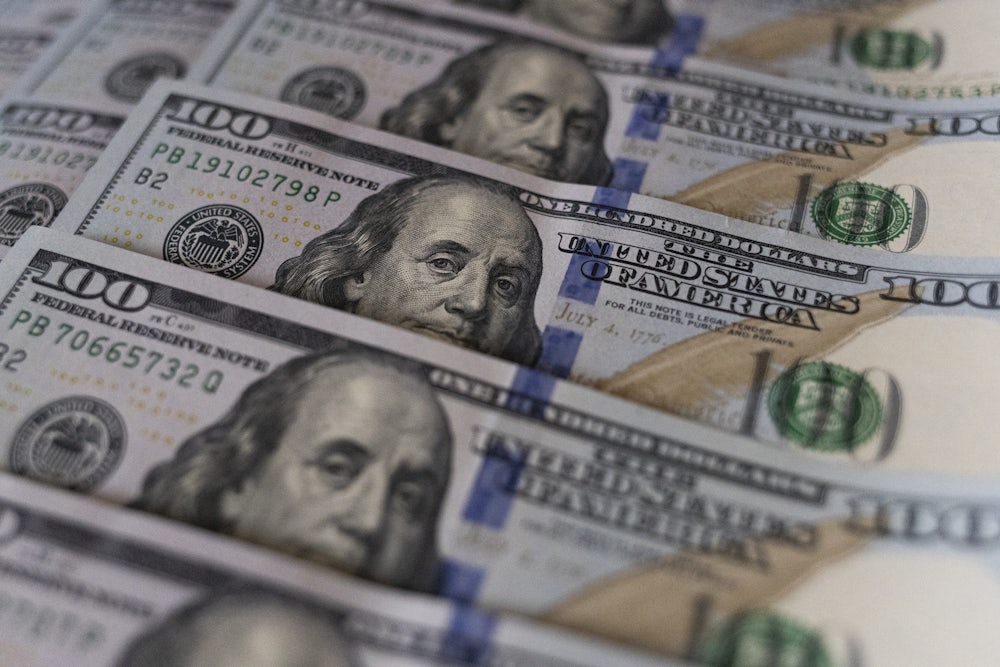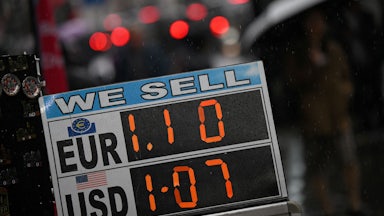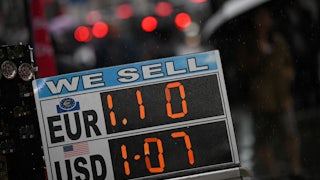Did you know that the United States now produces more $100 bills than any other denomination? “The $100 bill overtook the $1 bill … six years ago,” Oliver Bullough reports in Mother Jones, “and the trend has accelerated since: At the end of 2022 there were 18.5 billion $100s out there, and the Treasury Department printed another 1.5 billion in 2023. Of the total value of currency in circulation, 80 percent consists of notes with Benjamin Franklin’s face on them.”
The Benjamin is king—even though, as, Bullough notes, “ATMs typically don’t dispense them.” Look in your wallet, dear reader. You won’t likely find any $100 bills, unless you have some special reason. Indeed, you won’t likely find much cash at all, which helps explain why the dollar bill (or the fiver or the sawbuck or the double sawbuck) is no longer in heavy circulation. After parking meters and taxi drivers started accepting credit cards about 15 years ago, America became, in large part, a cashless society. Poor folks still need cash if they don’t have bank accounts or credit cards or debit cards, but there aren’t enough of them and/or they don’t have sufficient cash to keep low denominations in heavy demand.
So who are these mystery people who keep Treasury presses rolling for hundred-dollar bills? Their two principal characteristics tend to be:
1) They are rich,
and
2) They are criminals.
I don’t mean to ignore the small class of people who hoard Benjamins for honest reasons. My wife, who is very honest, recently visited Egypt; she brought some Benjamins with her because she’d been told the tourism business in Egypt currently favors dollars over plastic and the struggling Egyptian pound. There are likewise honest people in various corrupt or otherwise unstable countries throughout the world who keep their money in dollars because they have good reason not to trust the banks. But very few of these honest people actually need to keep their dollars in the form of Benjamins; if it came to it, they could keep this cash in denominations of $20 or $50. The only reason not to would be that $20s and $50s are harder than $100s to hide from the authorities. And with a very few exceptions—in certain very dangerous countries from which it’s difficult to escape—honest people don’t hide money from the authorities. Crooks do.
All this raises the question of why the U.S. continues to print $100 bills. It’s not a new question. As far back as May 1976, an economist named James Henry wrote an article in The Washington Monthly titled “Calling In the Big Bills” that proposed discontinuing not only $100 bills but also $50 bills (at that time worth more than $270 in 2024 dollars). Not only should the government stop printing these denominations, Henry wrote; it should recall all existing $100 and $50 bills and exchange them for lower denominations. Henry cited as his reason that these denominations were being used almost exclusively by organized crime and rich tax evaders.
The idea of recalling large denominations sounded outrageous, but the federal government had done it before. In 1945 the Treasury stopped printing $1,000 bills (graced with the face of Grover Cleveland) and $500 bills (William McKinley), and in 1969, at the direction of President Richard Nixon, the Treasury recalled the $1,000 bills, along with $5,000 bills (James Madison) and $10,000 bills (Salmon P. Chase). The reason Nixon gave was that these large denominations were used in money laundering. (Ironically, money laundering later featured heavily in the Watergate scandal that led to Nixon’s resignation. There were no money-laundering prosecutions, however, because Treasury was not yet geared up to enforce a statute outlawing it that Nixon had signed into law in 1970.)
Henry’s Washington Monthly piece generated some attention in the 1970s, according to an update he wrote for The National Interest in 2016. Henry was invited to testify before the Joint Economic Committee, and the Federal Reserve made available to him data on currency flows by denomination confirming that Florida, California, and Texas, all blessed with ready access to foreign markets, were “the key sources of net outflows of $100 bills.” But, as Henry reported, “nothing was done about the big bills.”
In December 2010, writing in Slate, I hopped aboard Henry’s bandwagon, though in more modest fashion, calling only for a ban on Benjamins. I extended clemency to the $50 because its value was a fraction of what it had been when Henry wrote his piece, and I dropped the idea of recalling $100s or $500s because I figured I’d have a hard enough time just persuading America to stop printing Benjamins. (Besides, at the time I wrote that piece, there were too few $500s left in circulation to matter.) I took the cause to CBS’s Sunday Morning show, where at the time I contributed occasional video essays. “This is a $100 bill,” I said, holding one to the camera.
It’s the currency of criminals, kleptocrats, and sociopaths.
Other people may use it, but nobody else needs it. ATMs almost never stock it.
Why does the U.S. Treasury continue to print it?
The argument didn’t go over well with libertarians. “Take Your Stinking Paws Off My Benjamins,” replied Daniel J. Mitchell of the Cato Institute. But Mitchell didn’t have much of an argument to make. He suggested that $100 bills were a valuable hedge against inflation—which was bad investment advice. Besides, if he really wanted to hoard cash, nothing would stop him from hoarding it in smaller denominations. He also said my argument “rests on the statist assumption that government should restrict honest people because this will somehow make life more difficult for criminals,” which was true, I guess. As statist restrictions go, though, I was proposing a pretty light one. Mitchell went on to say that crimes such as money laundering and drug trafficking persisted despite Nixon’s elimination of denominations above $500. True enough. But Mitchell didn’t consider why that was true. According to Bullough, the bad guys just started using $100 bills instead.
Does the availability of $100 bills help the U.S. maintain the dollar as the world’s leading currency? No. The classic formulation is that we give foreigners dollars and they give us automobiles and computers and whatnot. But these aren’t cash transactions; what we usually hand over aren’t Benjamins but bank deposits. As I noted in 2010, a $100 bill doesn’t generate interest; rather, it loses value over time. (That’s why Mitchell was foolish to recommend cash hoarding as an inflation hedge.) Christopher J. Neely of the St. Louis Fed published a fanciful essay in October arguing that when Americans export physical dollars for goods, that’s a fantastic deal for Americans because physical dollars cost only pennies to make. But little blips on a computer screen cost even less to make.
Benjamins are produced almost exclusively for export. Since 1980, the proportion of $100 bills that reside outside the U.S. has risen from 30 percent to nearly 80 percent. The overwhelming majority of those who possess these bills are criminals of one kind or another who want to stash their money overseas; the reason the U.S. keeps producing Benjamins is that it wants its currency to maintain dominance in this criminal market. That’s freaking insane.
When I wrote my Slate piece in 2010 there were nervous murmurings about the 500 euro note (equivalent to $545), which had been introduced in 2002, displacing the Benjamin within the underground economy. Before U.S. forces killed Al Qaeda’s leader, the 500 euro note was actually nicknamed “the Bin Laden.” By 2016, Henry reported in The National Interest, more than 25 percent of all 500 euro notes resided in Spain. Spain is one of the poorer nations in Western Europe (in 2020 it ranked sixth, behind Russia). But, crucially, Henry wrote, it is “the EU’s major entrepôt for drug traffic.”
Larry Summers wrote in 2016 that when he was Treasury secretary in the late 1990s he got very cross with the European Union about its plans to issue the 500 euro note. He let Brussels know that “in the context of an international agreement,” the U.S. “would consider policy regarding the $100 bill.” Nothing happened, Summers explained, because the Germans wouldn’t play ball. But if the Germans wouldn’t play ball, why didn’t we move unilaterally and just stop printing the $100 bill? Abandoning this international black market to the Eurozone threatened no legitimate commerce in the U.S. Moreover, by acting first, the U.S. might have acquired some leverage over Germany through acquiring the moral high ground. It’s hard to shame the EU while we’re merrily printing the favored currency of the criminal class.
I’ve never heard an even halfway-convincing argument for continuing to print $100 bills when we know exactly the nefarious purposes they’ll serve. According to Bullough, even cryptocurrencies take a back seat these days to hard cash when it comes to untraceability. It’s amazing to me that we’re still talking about this almost half a century after Henry first brought it up. Nixon was a bad man and a bad president, and, yes, his campaign employed money launderers. But Nixon had the right idea about calling in the big bills, and it’s past time that we heeded him.










